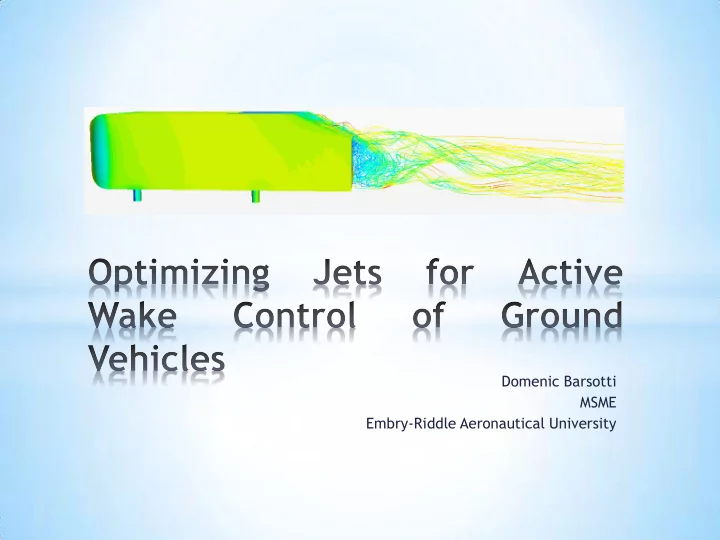

Domenic Barsotti MSME Embry-Riddle Aeronautical University
* Introduction * Real World Implications * Problem Description * Initial Simulations * Optimizations * Results Analysis * Future Work
* Environmental Impact * Current trends to reduce independence on oil * Development of Hybrid vehicles * Development of aerodynamically efficient vehicles * Drag is the leading negative force above 45 mph * Current Drag Reduction Systems (DRS) * Active Aero (rear wings, duct closing) * Smooth under panels
10% Mass Delta 10% Crr Delta 10% CD Delta Energy Consumption 6.47 1.91 3.49 [%] *Values are for 2013 Chevrolet Malibu
* In 1984, Ahmed {1} proposed a bluff body to simulate vehicle drag * Angle of slant varies from 0º-90º * 25º slant angle is most commonly used for typical automobile simulations {1} Ahmed, Ramm, Faltin (1984) “Some Salient Features of the Time - Averaged Ground Vehicle Wake” SAE 840300
* Domain is 1.4m x 1.86m x 8.5m * Blockage ratio= 4.3% * Mesh Continua * Polyhedral Mesher * Prism Layer Mesher * Surface Remesher
* Base Size = 0.005 m * Mesh Independence * 20.5 million cells Mesh Independence 0.365 0.36 Cd 0.355 0.35 17 22 27 Cell Count (millions)
* Implicit Unsteady * Constant Density * Segregated Flow Solver * SST K-Omega DES Turbulence Model * Improved Delayed Detached Eddy Simulation * Turbulence Viscosity Ratio – 200 * Turbulence Intensity – 0.02 * Time Step = 0.001 s * Total Simulation time = 1.5 s
* Initial Simulation was compared to experiment {2} * Reynolds Number Sweep from 1.4 to 2.8 million * Inlet Velocity 21 m/s to 42 m/s * Drag averaged from Time = 0.75 s to 1.5 s * Re = 1.4 million was chosen for highest Cd (0.371) Experimental {2} CFD 0.38 0.37 0.36 0.35 Cd 0.34 0.33 0.32 0.31 0.3 1.2 1.7 2.2 2.7 3.2 Re (millions) {2} Joseph, Amandolese , Aider (2012) “Drag Reduction on the 25º slant angle Ahmed reference body using pulsed jets” Exp Fluids
* Jets implemented at rear end * 4 Variables- velocity * 15m/s – 40 m/s * Drag averaged from 0.75 -1.5 sec * Objective function = minimize average Cd * 30 iterations
* Optimal Value was minimums (all jets 15 m/s) * Optimized Cd = 0.336 (9.4% reduction) * 10 m/s jets showed increase (Cd=0.339) * Showed critical information * Max drag reduction with jet velocities equal * Bottom and side jets were too thin to be effective
No Jets Optimized Jets (15 m/s)
* All jets changed to 10 mm thick * Bottom and side jets were 5mm * All velocities set equal * 1 Variable – velocity 8 m/s – 20 m/s * Objective function- Minimize Averaged Drag * 30 iterations
Optimized Cd = 0.316 (10.28 m/s) 0.345 0.34 0.335 Averaged Cd 0.33 0.325 0.32 0.315 0.31 8 10 12 14 16 18 20 Velocity (m/s)
* Averaged Cd = 0.316 (14.8% reduction) * Jet velocity of 10.28 m/s
* Design Exploration conducted using Optimate * Angle of bottom jet (0,5,10,15,20, 25º) * Height of top jet (39.2, 27.2, 15.2, 3.2 mm) * Conducted at 15 m/s jet velocity
* Found to be a non-critical * Value of mild significance dimension * 25 degrees – Cd= 0.3255 * Averaged Cd range (0.331- 3% reduction compared to 0.334) > 1% difference 0 degree * Costly computationally * Other angles were within 1 (requires remesh) count of each other * Future optimizations to not * Less computational (no include remesh required)
* All jets 10 mm thickness * Bottom jet angle increased to 25º * Top jet left at 39.2 mm distance * 1 design variable- velocity * 15 iterations * Objective function – minimize averaged Cd
Optimized Cd = 0.312 (10.2 m/s) 0.328 0.326 0.324 0.322 0.32 Cd 0.318 0.316 0.314 0.312 0.31 9 10 11 12 13 14 15 Jet Velocity (m/s)
* Critical Values found * Velocity (easily optimized- no remesh) * Angle (easily optimized- no remesh) * Non-critical values found * Distance of jets to edge * Reduced drag by 16%
No Jets Cd = 0.371 Optimized Jets Cd = 0.312
No Jets Cd = 0.371 Optimized Jets Cd = 0.312
* Determine impact of side jets * Investigate suction along top slant * Test jet system experimentally * Implement on full scale production vehicle
Domenic Barsotti BarsottD@my.erau.edu
Recommend
More recommend